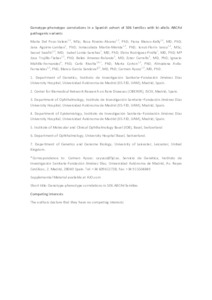Del Pozo-Valero, Marta and Riveiro-Alvarez, Rosa and Blanco-Kelly, Fiona and Aguirre-Lamban, Jana and Martin-Merida, Inmaculada and Iancu, Ionut-Florin and Swafiri, Saoud and Lorda-Sanchez, Isabel and Rodriguez-Pinilla, Elvira and Trujillo-Tiebas, Maria José and Jimenez-Rolando, Belen and Carreño, Ester and Mahillo-Fernandez, Ignacio and Rivolta, Carlo and Corton, Marta and Avila-Fernandez, Almudena and Garcia-Sandoval, Blanca and Ayuso, Carmen.
(2020)
Genotype-Phenotype Correlations in a Spanish Cohort of 506 Families With Biallelic ABCA4 Pathogenic Variants.
American journal of ophthalmology, 219.
pp. 195-204.
![[img]](https://edoc.unibas.ch/style/images/fileicons/application_pdf.png)  Preview |
|
PDF
- Accepted Version
5Mb |
Official URL: https://edoc.unibas.ch/79689/
Downloads: Statistics Overview
Abstract
To define genotype-phenotype correlations in the largest cohort study worldwide of patients with biallelic ABCA4 variants, including 434 patients with Stargardt disease (STGD1) and 72 with cone-rod dystrophy (CRD).; Cohort study.; We characterized 506 patients with ABCA4 variants using conventional genetic tools and next-generation sequencing technologies. Medical history and ophthalmologic data were obtained from 372 patients. Genotype-phenotype correlation studies were carried out for the following variables: variant type, age at symptom onset (AO), and clinical phenotype.; A total of 228 different pathogenic variants were identified in 506 ABCA4 patients, 50 of which were novel. Genotype-phenotype correlations showed that most of the patients with biallelic truncating variants presented with CRD and that these cases had a significantly earlier AO than patients with STGD1. Three missense variants are associated with CRD for the first time (c.1804C>T; p.[Arg602Trp], c.3056C>T; p.[Thr1019Met], and c.6320G>C; p.[Arg2107Pro]). Analysis of the most prevalent ABCA4 variant in Spain, c.3386G>T; p.(Arg1129Leu), revealed that is correlated to STGD1, later AO, and foveal sparing.; Our study, conducted in the largest ABCA4-associated disease cohort reported to date, updates the genotype-phenotype model established for ABCA4 variants and broadens the mutational spectrum of the gene. According to our observations, patients with ABCA4 presenting with 2 truncating variants may first present features of STGD1 but eventually develop rod dysfunction, and specific missense variants may be associated with a different phenotype, underscoring the importance of an accurate genetic diagnosis. Also, it is a prerequisite for enrollment in clinical trials, and to date, no other treatment has been approved for STGD1.
| Faculties and Departments: | 03 Faculty of Medicine
09 Associated Institutions > Institute of Molecular and Clinical Ophthalmology Basel (IOB)
09 Associated Institutions > Institute of Molecular and Clinical Ophthalmology Basel (IOB) > Research Group Rivolta IOB |
|---|
| UniBasel Contributors: | Rivolta, Carlo |
|---|
| Item Type: | Article, refereed |
|---|
| Article Subtype: | Research Article |
|---|
| Publisher: | Elsevier |
|---|
| ISSN: | 0002-9394 |
|---|
| e-ISSN: | 1879-1891 |
|---|
| Note: | Publication type according to Uni Basel Research Database: Journal article |
|---|
| Language: | English |
|---|
| Related URLs: | |
|---|
| Identification Number: | |
|---|
| edoc DOI: | |
|---|
| Last Modified: | 30 Jun 2021 01:30 |
|---|
| Deposited On: | 23 Dec 2020 10:20 |
|---|
Repository Staff Only: item control page
